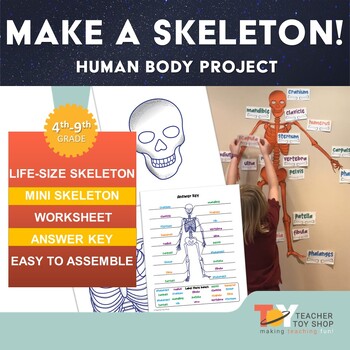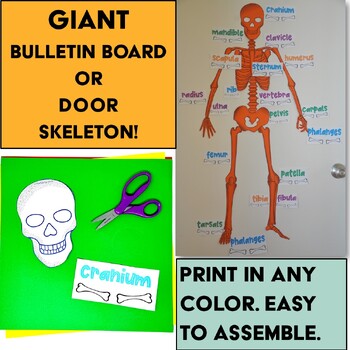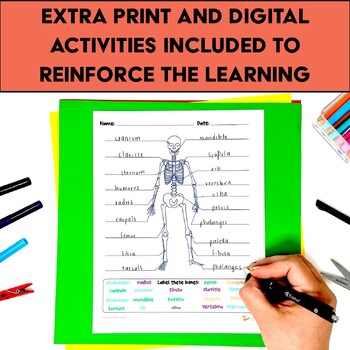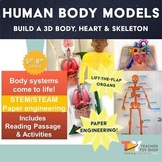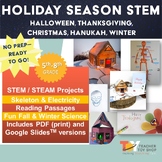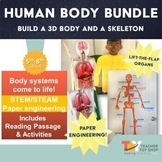*Printable Skeleton Labeling Project for Anatomy and Biology or Halloween
- PDF
- Easel Activity
- Easel Assessment
What educators are saying
Also included in
- Enhance the excitement of the spooky season with these Science Projects and Activities for Halloween and October, designed to infuse learning with spooktacular fun. Engage students with interactive lessons and projects that explore a variety of scientific concepts while celebrating the Halloween seaPrice $9.99Original Price $11.98Save $1.99
- Make anatomy models out of paper! Learn about human body systems while making these models. They're EASY and require only paper, tape and glue. Students will gain an understanding of the major systems of the human body and have a final project they are VERY proud of. These human body projects make tPrice $18.99Original Price $23.49Save $4.50
- Totally WOW science projects for Halloween, Thanksgiving, Christmas, Chanukkah and the winter season. Students assemble a skeleton, make a pop up light up haunted house, make a light up Thanksgiving card, and make a 3D winter house with a Christmas, Hanukkah, and/or Winter theme. Or use the blank tePrice $17.99Original Price $22.96Save $4.97
- All of Teacher Toy Shop's Life Science resources in one place! Some biology topics included: cells, ecosystems, human body systems and organs, flowers, reproduction, human eye, and more. Includes NGSS aligned lessons, experiments using the Scientific Method, and more.Purchase this bundle for a low-pPrice $49.99Original Price $80.66Save $30.67
- Looking for comprehensive and engaging resources to study human anatomy? Download Human Body Systems Projects Bundle - STEAM Activities! This dynamic bundle features two captivating paper engineering STEAM projects that provide an immersive and hands-on exploration of the human body and its systems.Price $10.99Original Price $13.24Save $2.25
Description
Looking for an engrossing and educational resource to help students identify skeletal bones? Download Printable Skeleton Labeling Project for Anatomy and Biology! Engage your students in a hands-on exploration of the human skeleton system, making learning about bones, anatomy, and biology both interactive and enjoyable.
Perfect for year-round use, but especially for Halloween! This project creates the most amazing themed door décor! Students construct a 40-inch tall bulletin board skeleton, providing a visually impactful learning tool for your classroom.
► Key Features:
- Versatile Usage: Beyond classroom learning, this resource serves as a fantastic Halloween or Día de los Muertos door décor piece, adding an educational touch to seasonal festivities.
- Convenient Materials: With everything provided, including bone labels and numbered tabs, all you need to supply is standard 8.5x11in paper, scissors, and tape for a hassle-free and engaging learning experience.
- Educational Alignment: This resource directly supports teaching concepts such as designing solutions to human problems, constructing arguments about internal and external structures in plants and animals, and illustrating the hierarchical organization of interacting systems within multicellular organisms.
► What's Included:
- Large Skeleton Model: This 40-inch tall bulletin board skeleton is designed in 15 parts, accompanied by 19 bone labels for a comprehensive exploration of the human skeletal system.
- Small Skeleton Model: A convenient version that fits on standard 8.5x11in paper, ideal for interactive notebooks, classwork, group seatwork, or as a creative homework assignment.
- Interactive Worksheet: Reinforce learning with a worksheet featuring a skeletal system diagram for students to fill in the bones, complete with an answer key.
- EASEL Digital Activities:
- EASEL activity: A digital version of the worksheet, allowing students to drag and drop bone names to label parts of the skeleton.
- EASEL assessment: 5 digital multiple-choice questions about the skeleton, with audio included for accessibility and for students who prefer to hear questions and answers.
Whether for in-person or remote learning, Printable Skeleton Labeling Project for Anatomy and Biology brings anatomy to life, offering a dynamic and educational experience for students. Download this comprehensive resource today and watch your students become bone experts!
⚠️ BUNDLE & SAVE! ⚠️ Get two fascinating and complementary human body systems projects and SAVE when you purchase the Human Body Systems Projects Bundle - STEAM Activities!
You Might Also Like...
- GIANT Human Body Systems STEM Project
- Human Body Systems Projects Bundle | STEM Activities
- ALL of Teacher Toy Shop's Body Models Bundle
- Make a Pop-Up Flower
- Skeletal System Word Search
✪ Don't forget to follow Teacher Toy Shop to be the first to know about new products, sales and freebies!

